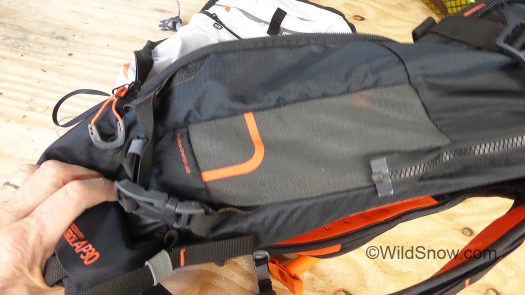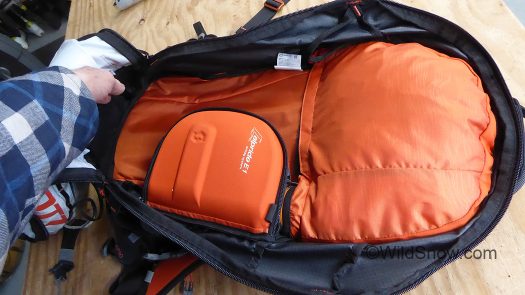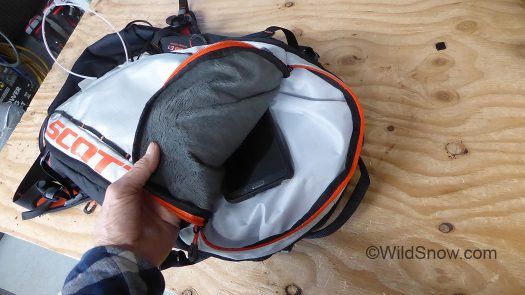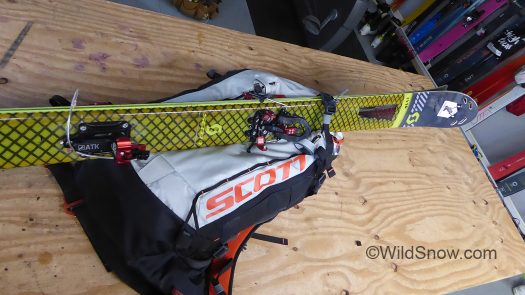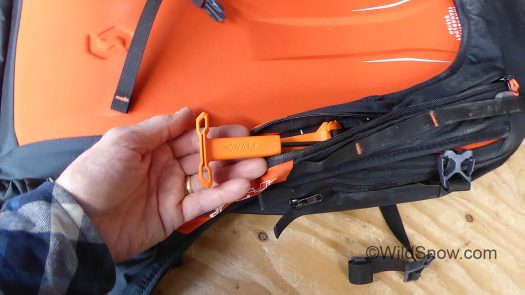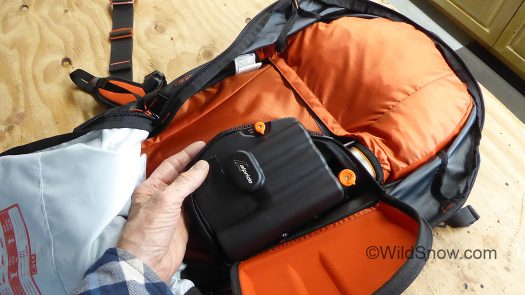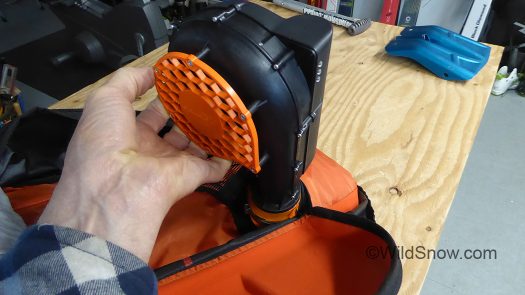Shop for avalanche airbag backpacks.
The so called “incremental” pace of product development? Not in the case of fast moving electric avalanche airbag rucksacks. In just a few short years we’ve got three* players who have quickly pushed the limits, latest being Scott boasting the shiny new Alpride E1 airbag technology — electrically powered by sleek supercapacitors instead of the enormous batteries used by other brands.
We happen to have the Scott Backcountry Patrol AP30 rucksack, equipped with the E1 system, here in the microbe free confines of the WildSnow evaluation laboratory. First look here, then we’ll get this guy out in the mountains on the shoulders of giants. For the sake of our wrist tendons and readability (see note at end of post), we’ll call the pack “AP30” or “Scott AP30,” and we’ll term the capacitor airbag system as “E1” or “E1 supercapacitor.”
(Previous WildSnow.com E1 coverage.)
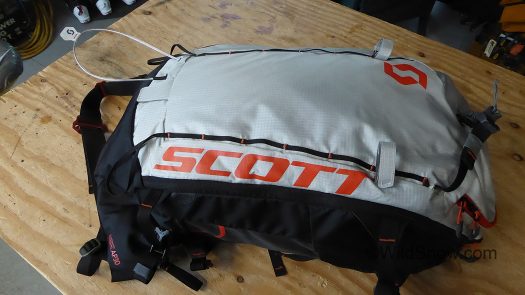
Scott AP30 rucksack equipped with E1 system weighs just under 6 pounds, is said to be a 30 liter sack. As is common with airbag backpacks, I’d call it a “small 30.” Commodious by European standards, adequate for lightweight style North American touring, but a larger pack would probably be desired by a number of readers. Rest assured, the E1 system is easily swapped between packs for which it’s enabled, and we’re certain Scott and others will eventually provide many pack size options that accept the system (AP30 will be only pack with E1 system for 2018-2019).
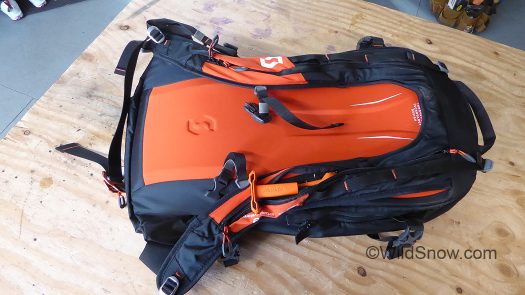
Backside. I like the smooth snow-agnostic back panel, and reasonable strapomania. No ditty bag on the waist belt is a bummer but can be added aftermarket. We’d like to see minimalist gear loops on the belt as well, but they do add weight and are not essential for perhaps the majority of users. A commenter asked about the belt not having padding. We like that,
idea is to not carry enough weight to need waist padding. But if that’s a deal breaker for you, so be it.
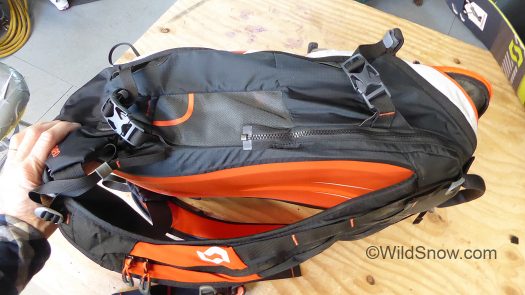
Getting specific to the E1 airbag system. Viewed from the side, system LED indicator lights show through a mesh panel purposed for air ingress during inflation. The LEDs flash too quick to photograph, but are adequately visible. Green for charged and activated.
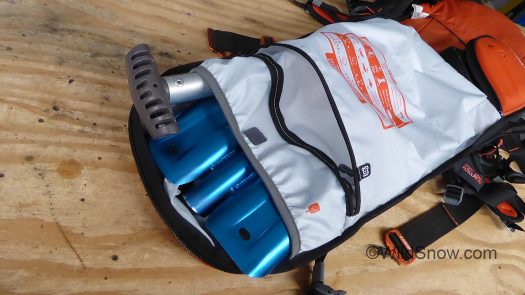
AP30 rear panel has several layers of tool and accessory storage. If you prefer one simple compartment these can be easily scissored out along with some other redundant fabric layers.
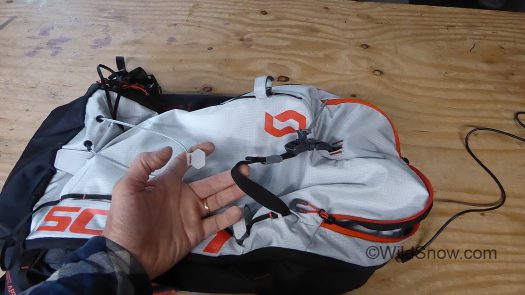
Diagonal ski carry system. Cable loop to left holds ski tails, is internally connected to strap at right which you cinch to tightly hold skis. The concept works nicely,
but needs a tweak (see below).
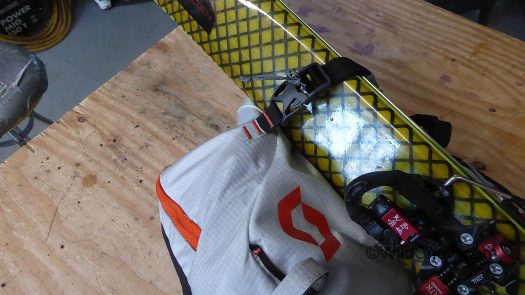
The only design flaw I could find will probably be remedied in the retail version. Ski carry compression strap is anchored on the wrong side of the goggle pocket zipper, needs an internal strap pulling on a stronger area of the pack. What about A-frame carry? You could do it, just as you can carry two vertical skis on the pack sides, but in my opinion either method compromises airbag deployment. Frankly, I’ve never seen any way of strapping skis to an airbag backpack that did not impact an inflating balloon, except perhaps attaching skis in an exaggerated diagonal that keeps them entirely away from the balloon. One important factor in this is how aggressively the airbag inflates, to perhaps compensate for obstructions such as skis or moving snow. In my bench testing, the E1 fan (actually a turbine if you want to get technical) is surprisingly and gratifyingly aggressive.
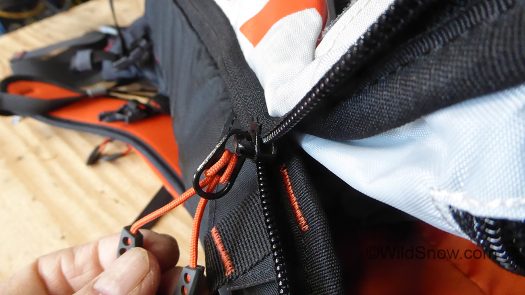
Main cargo compartment zipper is minimal, thus saving weight, but one grade up in beef might be wise.
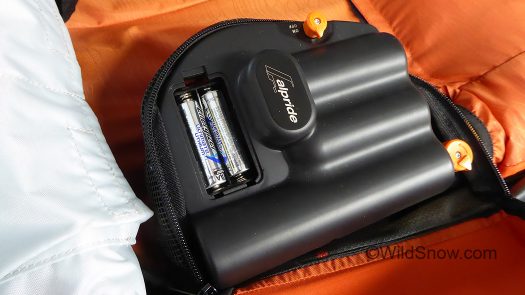
Who would have ever thought that 2 AA batteries could blow up an airbag backpack balloon? They have to first charge the capacitors to do so, takes about 40 minutes, but no lie the entire amount of required electricity can come from those two tiny batteries. In torture testing I actually got two full system charges out of one set AA lithiums, details below.
From Alpride, edited by WildSnow: The E1 Supercap Avalanche Airbag System is the first avalanche airbag that does not use lithium-ion or lithium polymer batteries for power. (WildSnow note: This is a big deal, rapid progress.)
The E1 system uses its supercapacitors to store energy in the form of an electrostatic field. Unlike traditional batteries, there is no need to create a chemical reaction to generate energy, allowing the E1 system to release its power faster.
The E1’s supercapacitors offer several advantages over batteries. Most importantly, they are not sensitive to changes in temperature, delivering the same performance at -30 degrees C and +50 degrees C. This saves weight because, unlike batteries, there is no need to boost the supercapacitors to guarantee outstanding performance at low temperatures. (WildSnow note: What are the downsides? At this point we are not sure. Supercapacitors lose charge gradually just as lithium-ion batteries do, only the supercaps deteriorate at a faster rate, hence the use of AA batteries to keep the charge topped off. Perhaps you electronics brains out there have more insights. Comments enabled!)
While batteries tend to wear out after repeated charges, the supercapacitors stay strong. They are guaranteed for 500,000 charging cycles, thus a nearly infinite lifespan in use for an airbag backpack, clearly superior to the several year lifespan of the average battery. What’s more, the SuperCapacitors are considered passive electronic elements, like cameras for example, so there are no restrictions to travel, shipping or storage.
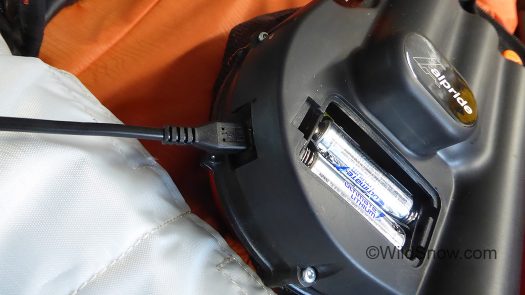
The capacitors can also be charged from standard USB. Once the system is charged the batteries can be optionally removed, and the charge will last a minimum of 6 hours (I tested this and the charge showed a green light for about 30 hours, which makes sense as safety device specifications are often quite conservative). I checked the USB port for use as a reverse power supply, sadly no go. When USB power is supplied, it takes priority over AA batteries, thus your expensive lithium AAs won’t get drawn down. See more about this below.
With an electrically charged system, the length of time it remains ready for use when disconnected from charging is called “autonomy.” Both lithium-ion batteries and capacitors gradually lose charge, capacitors at a more rapid rate. With fresh AA batteries, E1 is said to have 2-3 months autonomy. Without batteries, however, they claim a “minimum of 6 hours if green LED is flashing” I experimented and got much more than that, but it’s obvious the AA batteries should be installed during real-world use, thus making the system worry free in terms of how long your charge will last. That said, you can yank the AAs out in an emergency and use them to power a headlamp or whatever, and the system will remain ready for some time (again, Scott claims a minimum of six hours).
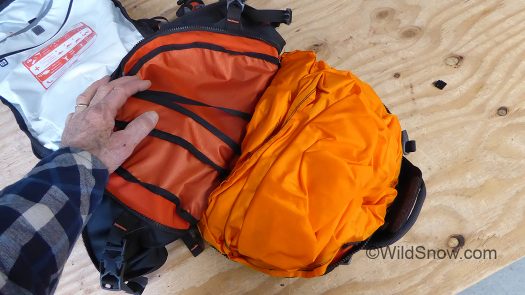
Balloon compartment uses the industry standard “birthing zipper” method of stowage and deployment. It’s not uncommon for such zippers to open too easily. I aggressively tested this zipper, it held well. Field testing will be important.
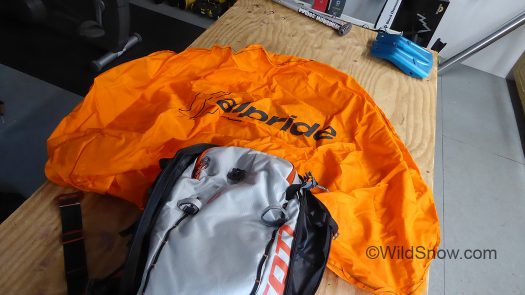
Unpacked balloon. My pet peeves with this, fiddly zippers and balloons that pack like your’e stuffing a six pound sack of cherries into a water bottle. In the case of E1 in AP 30 rucksack, the zipper is easily worked and space adequate, though as always I’d prefer slightly more.
How many inflations per charge? Rated as one. Once you inflate, the LED indicator flashes red, meaning you need to charge. I tortured tested and DID get an extra inflation while LED was flashing red, in other words obtaining two inflations for one charge. Bear in mind that if you have fresh AA batteries in a charged system, and deploy, the batteries will automatically recharge the system in a maximum of 40 minutes. All this is typical in the safety equipment industry, where systems are designed with multiple engineering factors.
Weights:
Alpride E1 airbag system, sans backpack, 1270 grams (2.8 pounds)
(For comparison, the lightest system out there is probably RAS 3.0 unit from Mammut with carbon cartridge, at ~1010 grams.)
Scott Backcountry Patrol AP30 rucksack 2670 grams (5.88 pounds) for pack and airbag engine system combined.
Pack without airbag system, 1,400 grams (3.1 pounds)
Lastly, charge versus inflation tests. I left the AP30 pack powered up for about 48 hours. Without AA batteries installed and the LED eventually flashing orange, I still got an entirely adequate balloon fill. Impressive. Everything I check in terms of this system’s electronics appears to be engineered with an excessive safety margin. Out of curiosity I attempted getting additional full system charges out of one set AA lithium batteries, amazingly, I got _FOUR_ charge and inflation cycles. That’s incredible.
*Note 1, to the best of our knowledge Black Diamond has indeed discontinued Jetforce 1 in that they’ve ceased production and it’s been removed from their order forms. Apparently there are Jetforce packs still in the pipeline, Black Diamond’s website has them listed, as well as Backcountry.com. It would seem to me that with the Alpride E1 system coming on strong for next winter, you might soon find excellent deals on the Jetforce. It’s a heavy pack, but if you don’t mind the weight it works fine and has excellent features. See our extensive Jetforce coverage.
*Note 2, Wildsnow department of marketing spreech official product names:
– Scott backpack product name: Scott Backcountry Patrol AP 30
(Scott likes their name in print as all caps, we’re not going there.)
– Technology: Alpride E1 Airbag Technology
Addendum, words from Alpride E1 system engineer-developer, edited for clarity from Swiss-French translation.
The Alpride E1 design philosophy was to have the lighter, easier and very robust electrical avalanche airbag, pretty close in weight and performance to compressed gas systems, but electrical.
The electronic design is designed to have no wires (can succumb to antenna effect) and no connectors (bad contacts), all the components are directly soldered on the PCB (Print Circuit Board) for example LED, ON/OFF switch, trigger switch, super capacitors are directly welded without any connectors – the trigger is a cable, same as the Alpride 2.0 gas system. The motor cables are screwed on the PCB without connectors.
There no electronics at all outside the PCB. On the PCB, we have a passivation – waterproof layer – to avoid any electrical issues with moisture due to condensation.
Autotest when turning ON, checks 15 points in the electronic: SuperCap, switch, motor, ett.
Inflation: the normal inflation of the balloon is done in 3.2 – 3.4 seconds and the motor turns 6 seconds to have enough reserve. Even if the supercaps are not fully charge (blinking in red) we will allow an inflation and push all the power we have in the supercaps, the philosophy is to inflate all what we can, all the time. (WildSnow note: we have observed this to be true, more, we did five full charge and inflation cycles with one set of AA batteries.)
As the balloon and non-return valve is airtight, we don’t need to pulse air after these 6 seconds. The argument that pulsing air input works to compensate for a small hole or tear works during tests at home. But in real life use, with the pressure of snow in an avalanche a torn or holed balloon will deflate in all cases, even if you are pulsing air in the amounts of our current competitors it is difficult or impossible to overcome a leak in the balloon.
Inflation pressure: to have the maximum of static pressure and force at the beginning of inflation – to ensure that the balloon can go out of the backpack and inflate, even during an avalanche – we are turning at 60’000 RPM during 2.5 seconds and we reduce the speed after 2.5 seconds to 40’000 RPM, in order to reduce the pressure inside the balloon: to much pressure is not useful anymore at the end of inflation and causes extra wear and tear on the system.
There is no measure of the balloon inside pressure with sensors, to have a robust system we don’t use sensor (in aircraft and even automobiles for that matter, sensors are a main source of problems) and we are always applying the same inflation cycle.
After inflation, the balloon remains inflated minimum 3 minutes (following the CE norm) but it stay inflated longer, there is no deflation process, it’s exactly the same as gas systems. Due to gradual leakage through the fan system the E1 Balloon does gradually deflate to a small degree and would do so more readily if actually buried and under pressure, but this is not a design feature we calibrate or specify.
The supercapacitors are electronic passive elements, there is thus no restriction for travelling, shipping and storage. In our opinion this is the first airbag 100% compatible to e-business, you can ship it worldwide with Fedex, UPS — with no warning labels or special considerations. Impossible with gas cartridges or large Li-Ion batteries.
The E1 system is CE/TüV certified and we have passed all the very difficult tests without any problems.
The E1 is certified for 50 inflations. We have to make 100 inflations for certify 50, thus proving a good engineering safety margin. Better, we have a sample of the E1 system in testing for months and have done 10,000 inflations (without backpack) without any problems or undue wear, unbelievable.
Shop for avalanche airbag backpacks.
WildSnow.com publisher emeritus and founder Lou (Louis Dawson) has a 50+ years career in climbing, backcountry skiing and ski mountaineering. He was the first person in history to ski down all 54 Colorado 14,000-foot peaks, has authored numerous books about about backcountry skiing, and has skied from the summit of Denali in Alaska, North America’s highest mountain.

